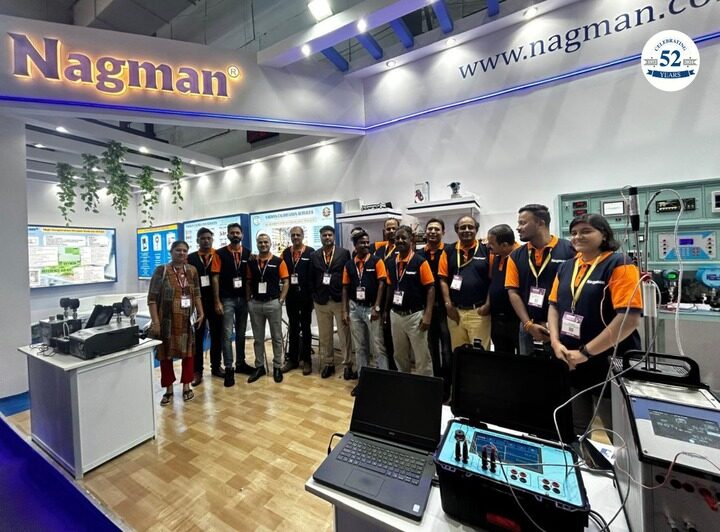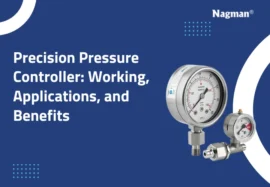Temperature sensors are widely used in household appliances like refrigerators, microwaves, water heaters, and thermometers. They are also essential in industries such as geotechnical monitoring, railways, bridges, and concrete construction. Accurate temperature sensor calibration ensures reliable, reproducible, and documented readings by comparing the tested sensor or data logger with reference equipment. In this blog, we explore the types, applications, and calibration of temperature sensors, highlighting their crucial role in labs and industrial processes
What are the temperature sensors?
A temperature sensor, like a thermocouple or Resistance Temperature Detector (RTD), measures temperature and converts it into an electrical signal for monitoring or control.
The simplest form, a thermometer, indicates heat levels in degrees, and is vital in applications such as concrete, soil, water, bridges, and geotechnical monitoring. Temperature sensors help detect structural changes caused by seasonal variations and environmental conditions.
Thermocouples (T/C): Made of two different metals, producing a voltage proportional to temperature changes.
Resistance Temperature Detectors (RTD): Variable resistors that change resistance precisely and linearly with temperature, ensuring accurate measurements.
What do temperature sensors do?
Temperature sensors monitor and measure the degree of hotness or coolness of objects, converting it into electrical signals for accurate readings. Temperature sensor calibration ensures these measurements are reliable, reproducible, and traceable by comparing them with highly precise reference instruments in accredited laboratories.
During calibration, devices are exposed to stable conditions using dry blocks or baths. The hardware adjusts over a set interval to reach the target temperature, ensuring consistent and accurate readings across different measurement points.
These sensors are essential in industries like geotechnical monitoring, power plants, concrete structures, and industrial processes, helping detect variations caused by environmental changes or seasonal effects. Accurate measurements from sensors like thermocouples and RTDs ensure safety, quality control, and compliance with industry standards
What are the functions of temperature sensors?
Temperature sensors serve crucial roles in both industrial and laboratory applications. They are generally categorized into contact and non-contact sensors:
Contact Sensors: Devices like thermocouples and thermistors measure temperature by direct contact with the object, providing precise readings.
Non-Contact Sensors: These sensors detect thermal radiation from a heat source, ideal for hazardous environments such as nuclear plants and thermal power stations.
In geotechnical monitoring, temperature sensors and temperature calibrators track the heat of hydration in mass concrete and monitor groundwater migration. They are essential during the concrete curing process, which requires consistent warmth, and help detect structural changes caused by seasonal expansion or contraction.
Benefits of Regular Temperature Sensor Calibration
Regular calibration of temperature sensors offers multiple benefits for industries and labs:
- Accuracy: Ensures sensors provide precise readings, avoiding errors in processes or experiments.
- Compliance: Meets regulatory standards and industry norms, including ISO and ASTM guidelines.
- Safety: Prevents equipment failures and hazardous conditions in critical environments like chemical plants or nuclear facilities.
- Cost Savings: Early detection of faulty sensors reduces maintenance costs and prevents downtime.
- Extended Equipment Life: Calibrated sensors experience less wear and maintain performance over time.
- Enhanced Decision-Making: Reliable data supports process optimization, research outcomes, and operational efficiency.
How does a temperature sensor work?
The basic principle behind temperature sensors involves the voltage across the diode terminals: as voltage increases, so does temperature, which leads to a voltage drop between the base and emitter terminals of the transistor.
The vibrating wire temperature meter operates on the principle that dissimilar metals have different linear coefficients of thermal expansion. It consists of a high-tensile-strength wire stretched between two fixed metal points. Any temperature change alters the tension in the wire, affecting its natural vibration frequency.
In the Encardio Rite temperature meter, the dissimilar metal used is aluminium, which has a higher coefficient of thermal expansion than steel. As the temperature changes, this variation is converted into a frequency signal. A similar readout unit is used for other vibrating wire sensors that can be utilised to monitor temperature effectively and efficiently.
Temperature changes are sensed by the specialised Encardio Rite vibrating wire sensor, which converts the information into an electrical signal transmitted as a frequency to the readout unit.
Conclusion
Temperature calibrators play a vital role in ensuring safety, quality control, and compliance with industry standards. Regular temperature sensor calibration helps detect instrument issues early, prevents equipment failures, extends instrument lifespan, and guarantees accurate data for temperature-sensitive operations and experiments.
By maintaining calibrated instruments, companies demonstrate a commitment to quality and reliability, which boosts customer trust and confidence in their products and services.
Partner with Nagman Instruments for precise temperature calibration solutions. We offer a range of services to ensure accuracy, compliance, and safety in laboratories and industrial processes. Contact us today to get a quote and experience reliable calibration services.
Also Read: Guidelines on the Calibration of Temperature Indicators and Simulators






